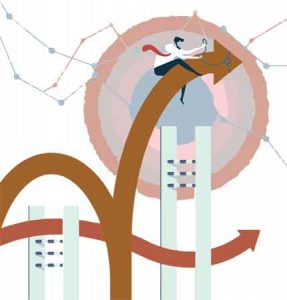After almost two months of economic lockdown by May 15, we pray that circumstances would be more conducive to slowly opening up the economy. We should now be preparing to pick up the pieces and to bounce back. Are we ready?
Public finance is critical.
John Maynard Keynes expressed confidence that while markets are able to self-correct and allocate resources, Governments must intervene to bring about equity, efficiency and stability. In his book, Stabilizing an Unstable Economy (1986), Hyman Minsky echoed this. He stressed that Government must smoothen swings in private investment for profits and employment to remain stable. These precarious swings are most apparent during a pandemic.
In the Philippines, the public sector’s final consumption is around 12%. In this regard, capital spending for the Build, Build, Build program is crucial. Pre-COVID-19, the Department of Public Works and Highways and the Department of Transportation were set to spend P581.7 billion and P100.6 billion, respectively, for 2020 infrastructure projects. These represent 25% and 45% increments over the previous year’s allocations and sum up to more than 6% of GDP.
COVID-19 has dramatically changed public priorities and the fiscal calculus.
Under the Government’s four-pillar socioeconomic strategy, additional funding of P305 billion is needed to subsidize 18 million poor families, provide wage support, and extend assistance to the agricultural sector. These items will help soften the expected drop in private consumption which accounts for more than 68% of GDP.
More than P35 billion was added to the original Department of Health budgetary share of P101 billion and the Universal Health Care budget of P172 billion. Some P171 billion was also earmarked for the Philippine Health Insurance Corporation.
The pandemic was an unforeseen intervening event that compels monetary and fiscal authorities to now provide the macroeconomy with assistance.
In particular, the Bangko Sentral extended provisional advances to the National Government. It also advanced its dividend. To ensure adequate liquidity, and help individuals and businesses, the RRR was reduced ahead of schedule. Policy rates were dropped. Regulatory forbearance gives banks more latitude to manage their loan portfolios.
Public finance is challenged with realigning the budget to accommodate the new money to fight COVID-19, while keeping to the 2020 budget of P4.1 trillion.
But under the law, some items like internal revenue allotments of local government units and debt servicing cannot be realigned. This leaves Government the difficulty of realigning the balance of capital spending by different agencies. The challenge is compounded as this is not much to begin with.
Acknowledging this, the Department of Budget and Management urgently issued a circular imposing a 35% reduction of programmed appropriations for 2020 and an additional 10% mandatory saving on nonessential expenditure. Congress objected.
Faced with a public health crisis, we expect a compromise between Congress and Malacañang on the amount to address the pandemic while continuing with infra projects already lined up for the year. This compromise must be swift, apolitical, and decisive.
At this point, the infra program has already lost two months during the lockdown. Government can thus keep the same pace and carry over to 2021 whatever was effectively lost between March 16 to May 15. While projects like roads and bridges should ideally not be sacrificed, some of these can reasonably wait given that the virus waits for no one and nothing in its rampage. Some food for thought.

At any rate, with or without congressional compromise, borrowing to finance the pre- and post-COVID-19 deficits is necessary. This reinforces the point of our fiscal authorities that Congress must then allow space so that Government can minimize loans and resort less to bond issuances to maintain debt sustainability.
Are we then ready to roll?
If we go by the success of the recent dollar funding exercise by the National Government, the international capital market appears ready for the Philippines.
In short, funds to bounce back are available. Rated Triple B+ by credit rating agency Standard & Poors, the April 29 pricing of the two dollar-denominated bonds reflects strong demand and what Finance Secretary Sonny Dominguez describes as “resiliency of investor interest in the Philippine economy despite the global economic fallout from the COVID-19 pandemic.”
From these bond issuances, we sourced $1.35 billion at 2.95% payable in 25 years, and another $1 billion at 2.457% due in 10 years. These are both definitely long in duration and low in coupon rate.
Earlier, the World Bank also granted us $500 million for our urgent needs. And $200 million was sourced from the Asian Development Bank to fund assistance to vulnerable sectors.
Paradoxically, there is much liquidity in both international and domestic capital markets. Augmenting the fiscal expansion of about $484 billion, the US Fed is pumping more liquidity into the system with its current and future Treasury purchases and easy monetary policy.
Japan is also into fiscal expansion given its higher supplementary budget from its Diet supported by BOJ’s ultra easy monetary policy.
Europe is not far behind. Fiscal support could be as much as 10% of GDP. The ECB is looking at bloating its balance sheet to around Euro 7.4 trillion, near 60% of its GDP.
The Philippine Government strategically took advantage of this short window of opportunity to finance its wider deficit and ensure victory over COVID-19. These moves also lay the groundwork for a shallower V or shorter U economic bounce back. Before the lockdown, domestic liquidity rose by nearly 11%. This will moderate as demand for credit slows with the industrial freeze.
Looking at private investments, the Department of Finance recently reported that small businesses may incur P465 billion in financial losses due to the pandemic. To address this, the Executive is coordinating with Congress to provide tax relief by extending the net operating loss carry-over (NOLCO) from three to five years. This allows small businesses to deduct this year’s losses from their income for the next five years. In effect, the National Government is helping absorb private losses in terms of foregone revenues. Credit guarantees up to P120 billion worth of loans to affected small businesses will also be provided.
Finally, the Bangko Sentral’s new policy of giving banks more time to re-classify their loans as past due and non-performing is also positive for business. It enables banks to exclude client loans — mostly by affected corporates — from being re-classified as past due and non-performing until end-December 2021. In the absence of this policy, banks would have been constrained to put up higher provisioning for potential loan losses. In addition, loans for small businesses are now assigned lower credit risk weight to encourage more bank lending to the sector.
On practically all fronts, Government is providing private businesses with great hand-holding to bounce back from the pandemic. The private sector is aptly assisted to forge on to economic recovery.
Time to bounce back.
Diwa C. Guinigundo is the former Deputy Governor for the Monetary and Economics Sector, the Bangko Sentral ng Pilipinas (BSP). He served the BSP for 41 years. In 2001-2003, he was Alternate Executive Director at the International Monetary Fund in Washington, DC. He is the senior pastor of the Fullness of Christ International Ministries in Mandaluyong.




